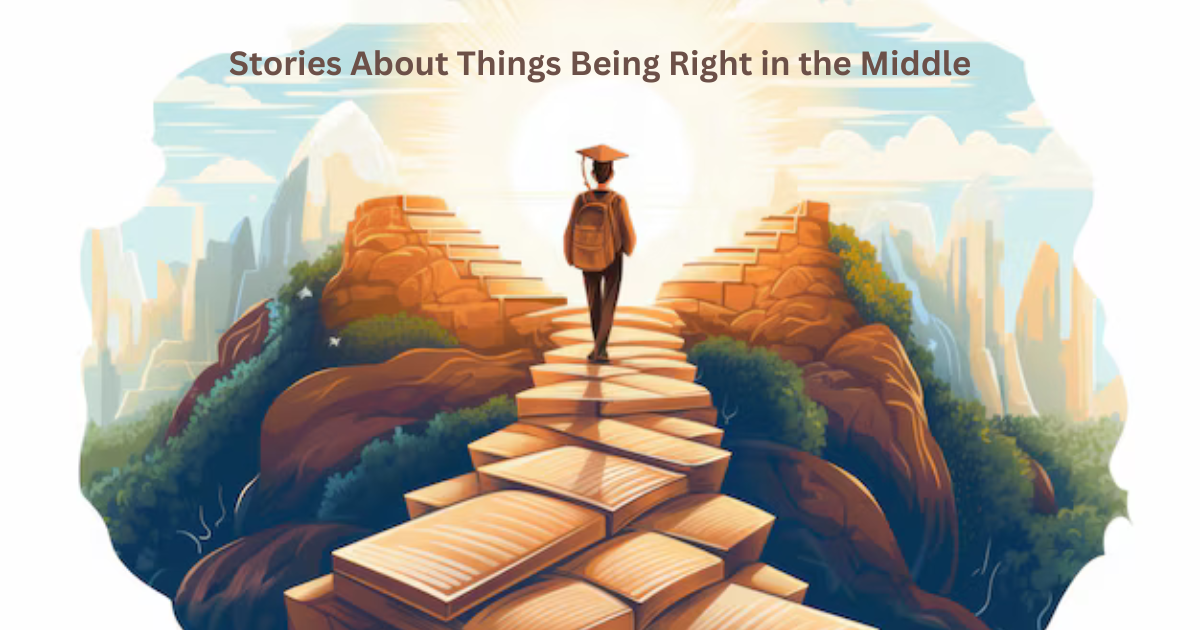ItThroughout history, stories of balance and equilibrium have fascinated people. Whether in literature, daily life, or even philosophical discussions,Stories About Things Being Right in the Middle has often represented fairness, justice, and harmony. The middle ground is where opposites meet, where compromise happens, and where tension finds resolution. From stories of split decisions to metaphors about life choices, the idea of the “middle” resonates deeply across various contexts. In this article, we explore stories that center on things being “right in the middle,” how this concept manifests in life and literature, and its symbolic significance. Additionally, we’ll answer some frequently asked questions to shed light on why the middle matters so much in human experiences.
The Middle: A Place of Balance
The idea of something being “right in the middle” can be seen as a metaphor for balance, fairness, and impartiality. Whether in personal relationships, political disputes, or moral dilemmas, the middle often represents a position where neither extreme dominates. It’s a space for compromise, where opposing views can coexist in harmony. For example, in many fairy tales and parables, the protagonist often finds themselves between two extremes—whether it’s choosing between good and evil, luxury and poverty, or strength and vulnerability. The middle is often the place where resolution occurs, and the character emerges with a balanced, nuanced perspective.
Stories That Highlight the Middle Ground
A Tale of Goldilocks and Three Bears
A well-known tale that embodies “the middle” is the tale of Goldilocks and the Three Bears. Three bowls of porridge are tested by Goldilocks in the story: one is too hot, one is too cold, and one is “just right.” This story encapsulates the notion of balance: locating the ideal midway point when conditions are neither excessively severe nor insufficient.
Charles Dickens’s Two Cities Tale
Dickens depicts Paris and London, two disparate cities during the French Revolution, in A Tale of Two Cities. Charles Darnay, the main character, is stuck between the two and represents a man who looks for equilibrium in a society where social and political unrest have split it apart. His trip through the turmoil of a revolution illustrates how life is frequently an attempt to find balance.
The Middle Path of the Buddha
The “Middle Path” is stress as the path to enlightenment in the Buddha’s teachings. promotes a life of moderation and balance as oppose to overwhelming pleasure or deprivation. This tale is now used as a guide for people who want to live wise and peaceful lives.
The Catch-22 of Fence-Sitters
There are sometimes two opposing sides in political or social events, yet neither side feels fully right or wrong. Those who remain unbiased or indifferent, or “fence-sitters,” end up in the middle of the argument. Being in the middle can also indicate that a person is receptive to learning about opposing viewpoints and identifying points of agreement, despite the criticism of some for their lack of clarity. Protagonists are frequently found in accounts of political mediators or negotiators.
Why Is the Middle Important?
Why is being “right in the middle” so important to people? The ability to perceive both sides of an issue and to maintain harmony and impartiality are represent by the center. It is frequently link to discernment and moderation.
In life, remaining in the middle might protect us from making premature judgments based on extreme emotions or ideas. We are more likely to come up with long-lasting solutions that respect all parties involved when we take into account all aspects of a disagreement or conflict. It is also possible to grow in the middle. We risk missing out on fresh viewpoints when we get overly commit to one side of a debate. But we can learn to adapt and change if we keep an open mind toward the middle ground.
Conclucion
Tales of “being right in the middle” have stood the test of time because they appeal to our shared need for justice and balance. Whether in everyday life, philosophy, or literature, striking a medium ground is frequently interpret as a sign of wisdom, endurance, and understanding. In a world full of extremes, tranquility is frequently found in the midst.
From tales like Goldilocks and the Three Bears to the teachings of the Buddha’s Middle Path, the necessity of balance and moderation continues to be a significant motif in storytelling. The teachings of finding the middle might help us make more harmonious and deliberate decisions as we traverse our own lives.
FAQ
Why are stories about “being right in the middle” so common?
Because they depict difficulties in real life achieving justice and balance, these stories have an emotional impact on viewers. Extreme viewpoints can frequently result in conflict or turmoil, whereas the middle ground frequently promotes harmony and understanding.
Are tales of “the middle” invariably center around giving in?
Not every time. Stories about the middle might emphasize neutrality, indecision, or the wisdom of balance, even if compromise is a recurring topic. The center can represent a deliberate and well-rounded viewpoint but isn’t necessarily necessary to represent a compromise.
Why does the idea of “just right” in stories appeal to people so much?
As in Goldilocks and the Three Bears, the idea of “just right” is pleasing because it embodies the ideal balance. Stories that highlight harmony and stability are relevant and soothing because humans are naturally draw to these concepts.
Is it ever bad to be in the middle?
Although the center is frequently regard favorably, it can also be associate with hesitancy or lack of commitment. Being indifferent might occasionally impede important development or action. Whether or not being in the middle is advantageous depends on the circumstances.
How can I use “finding the middle” lessons in my life?
Applying the concepts of balance and moderation can be beneficial in many parts of life, including decision-making, relationships, and dispute resolution. Seeking the middle ground enables you to weigh all viewpoints before making decisions, resulting in more deliberate and equitable decisions.










